Post-war service of tanks and self-propelled guns manufactured in Nazi Germany in the armed forces of other states
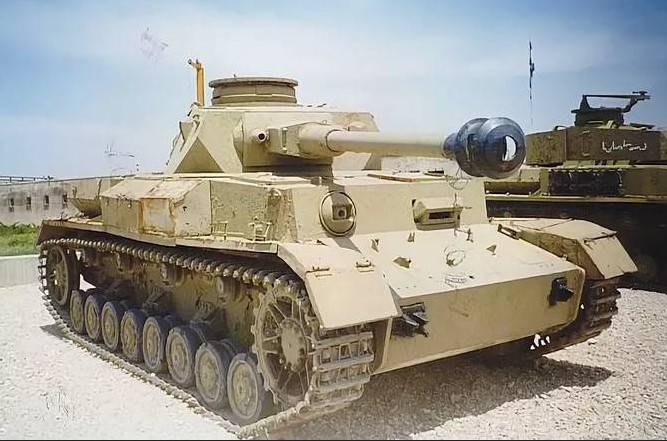
After the end of hostilities in the territories liberated from Nazi occupation, a significant amount of German-made armored vehicles remained serviceable or suitable for restoration. Some produced in Germany tanks and self-propelled artillery units were also available in states that officially purchased them before the surrender of the Third Reich.
In the post-war period, a number of countries operated German tanks and self-propelled guns for quite a long time, which, also being the object of resale, participated in the armed conflict in the Middle East.
Light tanks Pz.Kpfw.II
By the time Nazi Germany attacked the USSR, the Pz.Kpfw.II light tanks were largely outdated. An automatic 20-mm cannon made it possible to fight light armored vehicles and infantry, and the armor protected against bullets and shrapnel. A tank with such weapons and armor protection could be successfully used for reconnaissance and patrolling. Nevertheless, the “twos” and vehicles for various purposes created on their basis remained in service until the end of the war.
After the end of hostilities, serviceable Pz.Kpfw.II tanks were mostly decommissioned or converted into tractors and technical support vehicles.
It is reliably known that a number of captured “twos” were in the Yugoslav People’s Army, where they were operated together with light American tanks “Stuart” and Soviet “thirty-fours”.
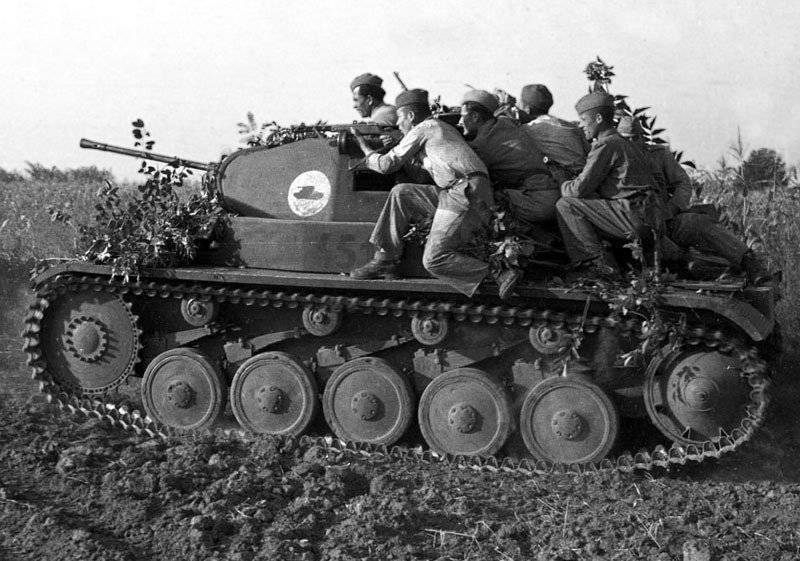
Light tank Pz.Kpfw.II during exercises of the Yugoslav People's Army
In 1947, Yugoslavia additionally received 308 T-34-85 tanks and 52 SU-76M self-propelled guns. Due to the saturation of troops with Soviet equipment in 1949, all Pz.Kpfw.II light tanks available on the move were withdrawn from combat units. In the early 1950s, several “twos” were used to train driver mechanics in a training unit stationed near Belgrade.
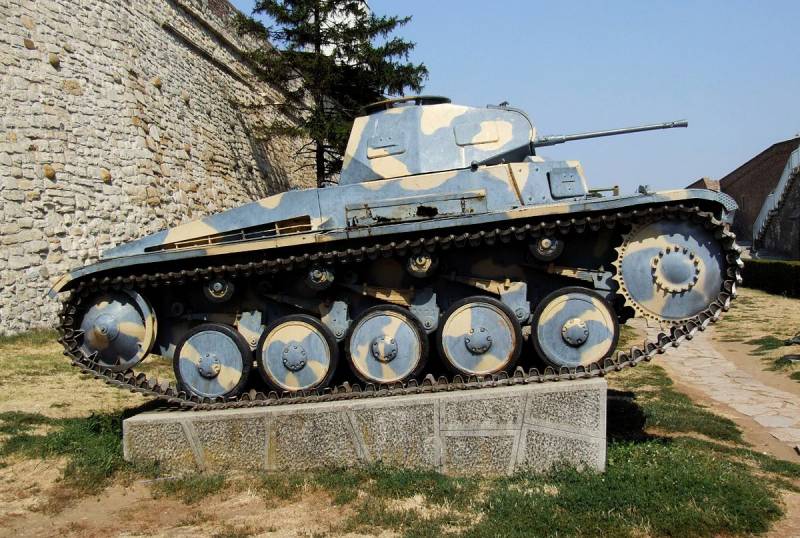
One surviving Pz.Kpfw.II Ausf. B is currently on display at the Military Museum in the Kalemegdan Fortress located in Belgrade.
Pz.Кpfw.III tanks and StuG.III self-propelled guns
In 1942-1944. Germany supplied Pz.Kpfw.III tanks to its allies: Italy (12 Pz.Kpfw.III Ausf. N), Croatia (20 Pz.Kpfw.III Ausf. N), Romania (11 Pz.Kpfw.III Ausf. N), Hungary (20 Pz.Kpfw.III Ausf. J) and Slovakia (5 Pz.Kpfw.III Ausf. J). For the most part, these vehicles were lost during the fighting.
The official buyer of Pz.Kpfw.III Ausf tanks. J also became the Turkish government. In 1943, 56 tanks armed with 50 mm KwK 39 cannons with a barrel length of 60 calibers arrived in Turkey.
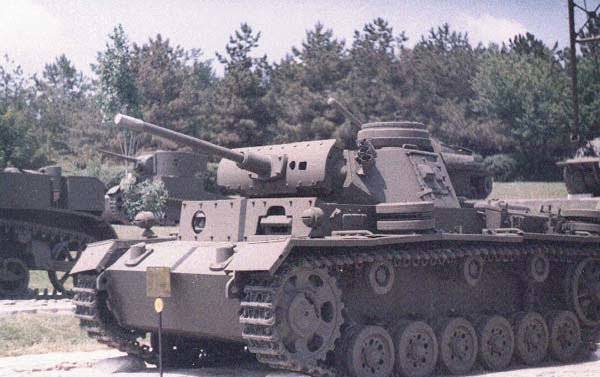
Pz.Kpfw.III Ausf. J on display at the Turkish Tank Museum Etimesgut
Although the Troikas were already obsolete at the time of sale, their operation as part of the 6th Armored Regiment, stationed in Ankara, continued until the mid-1950s.
Bulgaria used captured “troika” towers in long-term firing points located on the border with Turkey.
If the Pz.Kpfw.III tanks were used only in Turkey in the post-war period, then the StuG.III self-propelled guns created on the basis of the “troika” served in different countries for more than 20 years.
During World War II, Bulgaria, an ally of Nazi Germany, received 55 StuG.III Ausf self-propelled artillery units as part of the Barbara program, in addition to other armored vehicles. G, and these self-propelled guns were operated by the Bulgarian army in the post-war period. Thus, in the First Tank Brigade in 1946, in addition to German, Czech, French and Italian-made vehicles, there were 5 StuG.III self-propelled guns.
In 1943, 10 self-propelled guns StuG.III Ausf. G was bought by Spain, where they served until the late 1950s. Currently, one self-propelled gun is in a museum located at the El Goloso military base north of Madrid.
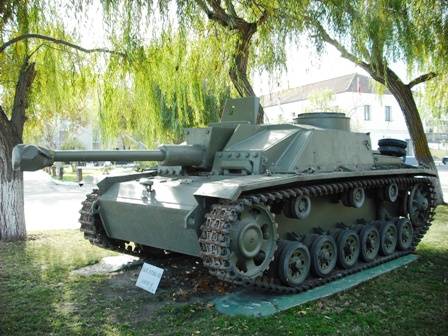
Self-propelled gun StuG.III Ausf. G in the Spanish Museum
In 1944, Finland received 29 StuG.III Ausf assault guns. G. For operation in wooded areas, the StuG.III self-propelled guns were modernized. The side screens were removed from them, and tracks, rollers and boxes with spare parts were hung on the sides. German MG.34 machine guns were replaced by Soviet DT-29.
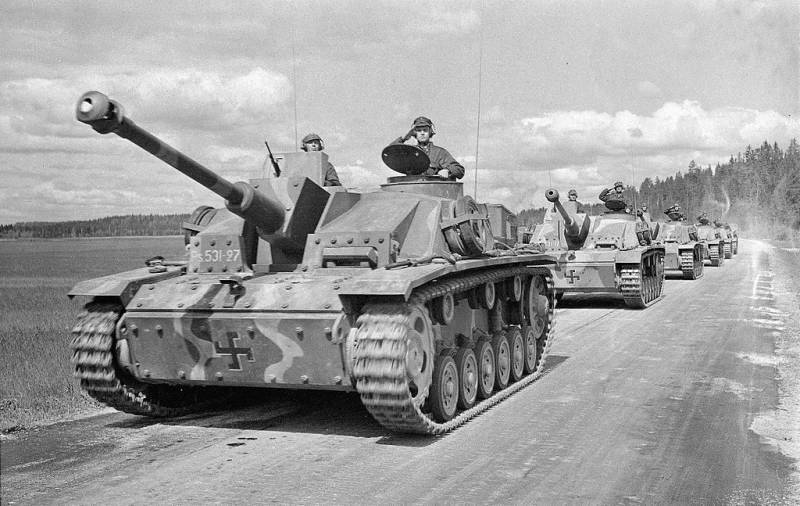
German-made self-propelled guns served in a tank division created on the basis of the 1st Jaeger Brigade. The same division had German tanks Pz.Kpfw.IV Ausf. J, Soviet T-26, T-28, T-34, T-38, T-50, KV-1.
After the conclusion of a truce with the USSR, clashes began with Wehrmacht units stationed in Lapland, in which German-made armored vehicles took part on the Finnish side.
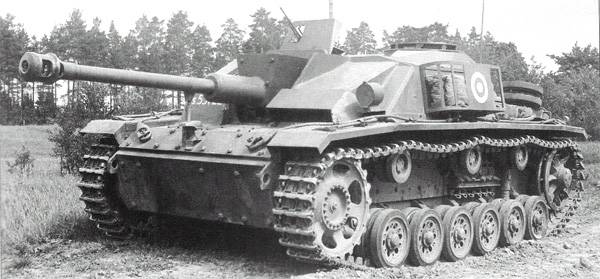
Subsequently, the only Finnish tank division was disbanded, and its equipment was transferred to storage. After the end of World War II, the tank fleet was reduced. In the first post-war decade, only T-34, Pz.Kpfw.IV and StuG.III remained in the Finnish armed forces. The final decommissioning of German-made self-propelled guns took place in the mid-1960s.
A large number of captured armored vehicles went to Czechoslovakia. In the summer of 1945, about 40 serviceable and repairable armored vehicles were assembled at a site near the town of Milovice, about 400 km north of Prague. In addition to this, the Soviet Union transferred about 1946 medium tanks and self-propelled guns to the Czechs in 300, and among these armored vehicles were StuG.III self-propelled artillery mounts and Bergepanzer III armored recovery vehicles. It is known that the StuG.III entered service with the 351st and 352nd self-propelled artillery regiments, where they were used until the end of the 1950s. The StuG.III self-propelled guns adopted for service in Czechoslovakia were named SD 75-40N.
Subsequently, part of the Czechoslovak self-propelled guns was sold to Syria. A number of sources claim that the Arabs bought 32 self-propelled guns, which were used as tank destroyers. Some self-propelled guns were equipped with turrets for anti-aircraft machine guns.
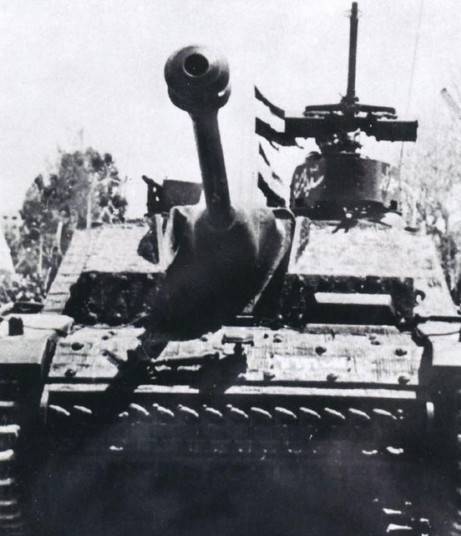
Syrian SPG StuG.III
Self-propelled guns StuG.III took part in the Arab-Israeli war of 1967, but in general they acted unsuccessfully, which is explained not by technical shortcomings, but by improper use and poor training of the crews.
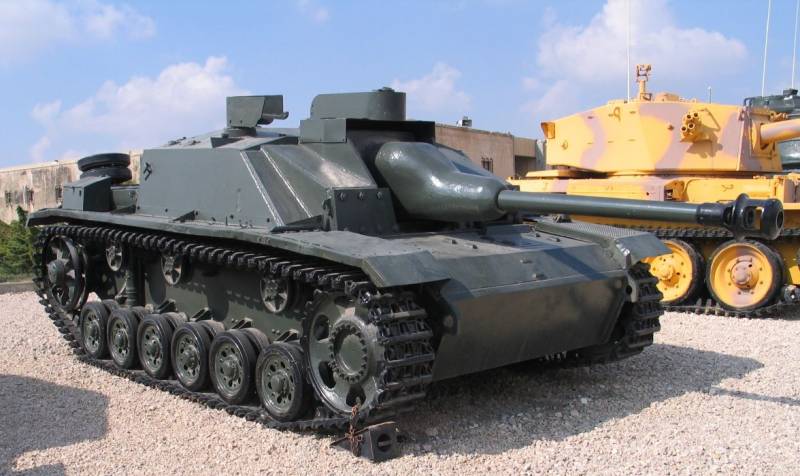
Several Syrian self-propelled guns are still rusting on the Golan Heights, one StuG.III is in the Israeli armored museum in Latrun.
Soon after Germany's surrender, Poland's armed forces were reinforced with captured armored vehicles. In June 1945, at the direction of the Soviet Headquarters of the Supreme High Command, it was ordered to transfer a large batch of German-made tanks and self-propelled guns to the 1st Polish Army, which was operationally subordinate to the Commander-in-Chief of the Group of Soviet Occupation Forces.
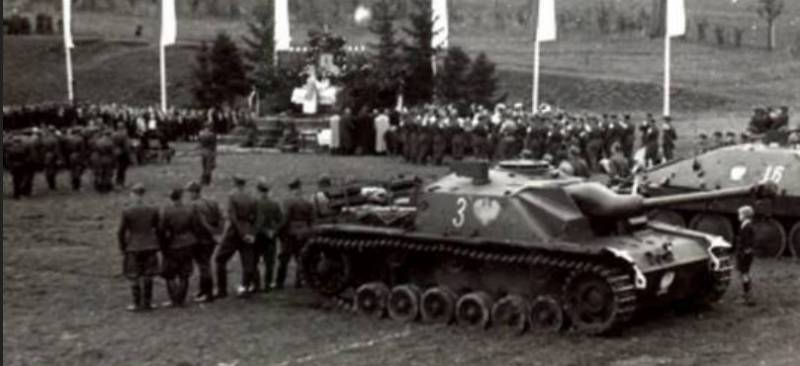
The Poles received fifty tracked armored vehicles from the German inheritance, including twelve StuG.III self-propelled artillery mounts. Their service was short-lived: literally a few years later, self-propelled guns produced on the territory of the Third Reich were supplanted in the Polish Army by the Soviet SU-76M and SU-100.
The Yugoslav People's Army received approximately three dozen StuG.III self-propelled guns. Which in 1947 were consolidated into a separate self-propelled artillery division.
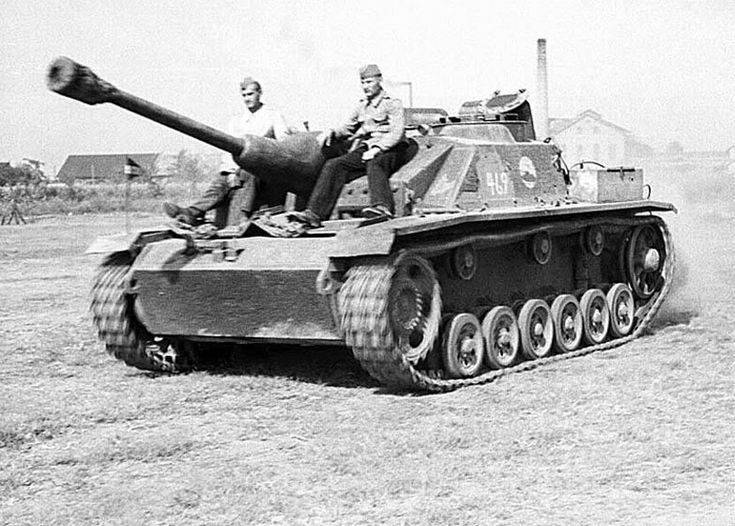
These captured self-propelled guns were actively used for six years, after which they were put into storage, where they remained until the end of the 1950s.
Pz.Kpfw.IV tanks and self-propelled guns based on them
At the same time as the StuG.III self-propelled guns, 61 Pz.Kpfw.IV Ausf tanks were transferred to Bulgaria. H. After it became clear that the Third Reich had no chance of winning the war, Bulgaria went over to the Allied side and declared war on Germany on September 8, 1944.
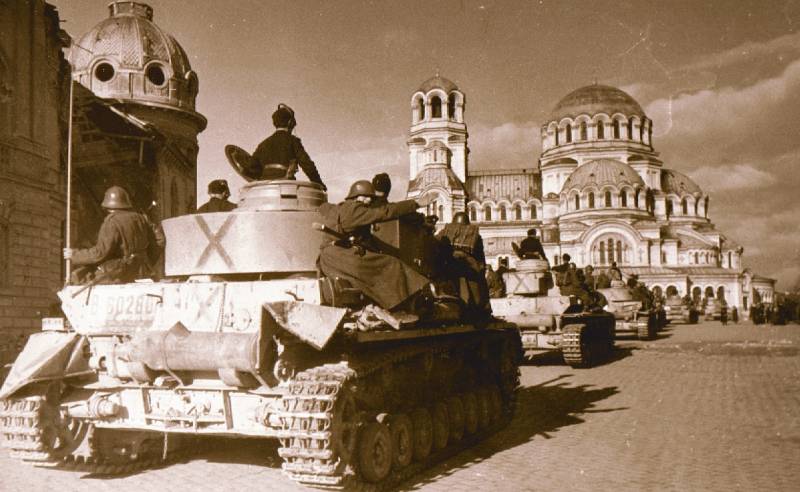
During the battles on the territory of Yugoslavia, the Bulgarian tank brigade lost a significant part of its equipment. Irreversible losses amounted to 20 tanks and 4 self-propelled guns.
To maintain the combat effectiveness of the Bulgarian armored forces, at the beginning of 1945, the command of the 3rd Ukrainian Front transferred several batches of captured tanks and self-propelled guns to Bulgaria. According to some reports, in total Bulgaria received 97 “fours” of modifications G, H and J.
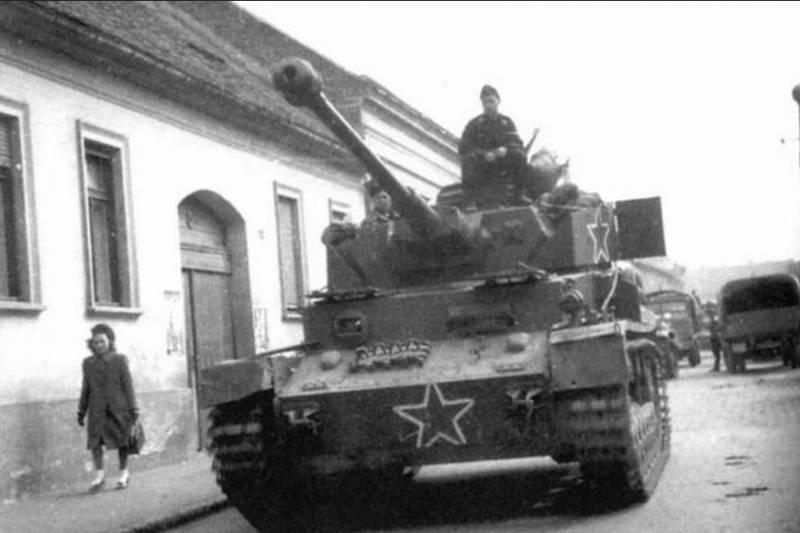
Bulgarian tank Pz.Kpfw.IV Ausf. H
In 1946, the Bulgarian 1st Tank Brigade, in addition to the StuG.III self-propelled guns, as well as Czech, French and Italian-made vehicles, had 57 German Pz.Kpfw.IV tanks and 15 Jagd.Pz.IV tank destroyers.
In the early 1950s, German-made tanks and self-propelled guns in the Bulgarian armed forces were almost completely replaced by the Soviet T-34-85 and SU-100. As of 1954, only 11 Pz.Kpfw.IV tanks remained in service. At the same time, a significant number of captured German tanks were in storage.
Subsequently, after the start of deliveries of T-55 tanks, German self-propelled guns, “troikas” and “fours”, as well as their turrets, were used in the construction of long-term firing points on the Bulgarian-Turkish border. The exact number of such bunkers is unknown. But various sources say that there could be about 150 units, of which only Pz.Kpfw.IV had more than 70 units. Taking into account the fact that Bulgaria itself did not have such a number of tanks and tank turrets with weapons, they were apparently received from the Warsaw Pact allies.
After the collapse of the Eastern Bloc, the German tanks and self-propelled guns of the Second World War that stood on the border with Turkey were forgotten for some time. The rare tanks were remembered in December 2007, after the Bulgarian police arrested thieves who stole a German-made tank on the Bulgarian-Turkish border and tried to illegally export it to Germany.
After this incident, which received wide resonance, the Bulgarian government took control of the restoration and trade of old armored vehicles. In total, the Bulgarians managed to restore 55 units of German armored vehicles, which they put up for auction. The price of each tank was several million euros.
Not for sale at auction, the Bulgarian authorities financed the restoration of four Pz.Kpfw.IV Ausf tanks. G/H/J, one StuG.III self-propelled gun and one Jagd.Pz.IV with a barrel length of 48 calibers.
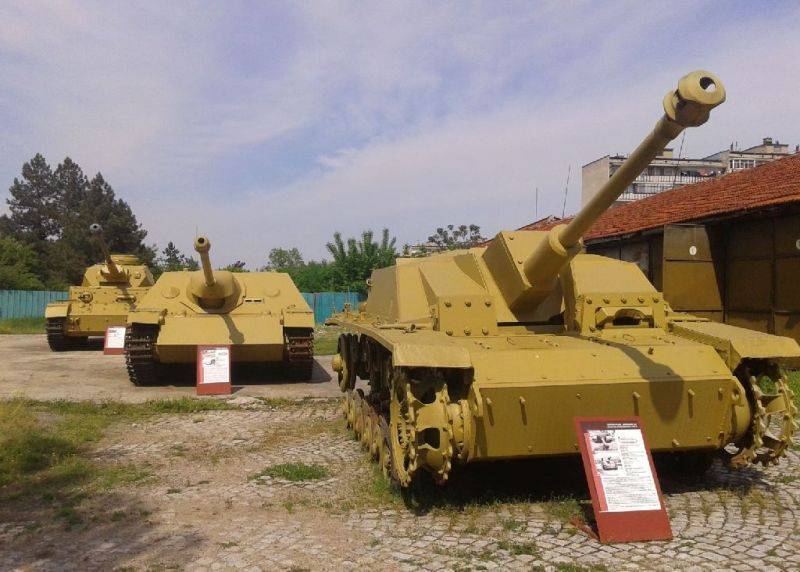
Now these restored tanks and self-propelled guns are in the Museum of Military Glory in the city of Yambol.
One of the main importers of German “fours” during the Second World War was Romania, which received 142 Pz.Кpfw.IV.
After Romania switched to the side of the anti-Hitler coalition, very few serviceable German-made armored vehicles remained in the Romanian army. In this regard, the 2nd Tank Regiment, which was attached to the Soviet 27th Tank Brigade (2nd Ukrainian Front), was reinforced in February-March 1945 with several captured “fours”, as well as self-propelled guns StuG.III, StuG.IV and "Hetzer". At the beginning of 1946, the Romanian tank regiment had four operational Pz.Kpfw.IV medium tanks.
Together with the Pzkpfw.III Ausf. J in Turkey since the end of 1943, 15 Pz.Kpfw.IV Ausf. G.
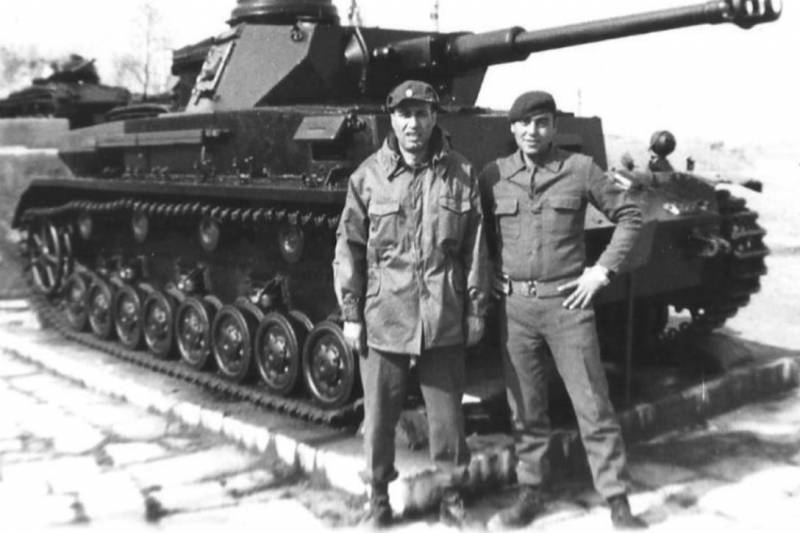
Turkish soldiers pose in front of a Pz.Кpfw.IV Ausf tank. G
Like the 50mm gun troikas, the German-made 1950s in the Turkish Armed Forces were withdrawn from service in the mid-XNUMXs.
Another country that received Pz.Kpfw.IV Ausf tanks in 1943. N, became Spain. Twenty “fours” with long-barreled 75-mm guns and 10 StuG.III self-propelled guns supplemented the 1st Brunet Tank Division with hopelessly outdated Italian and German CV-33 and Pz.Kpfw.I tankettes, as well as Soviet-made light tanks T- 26.
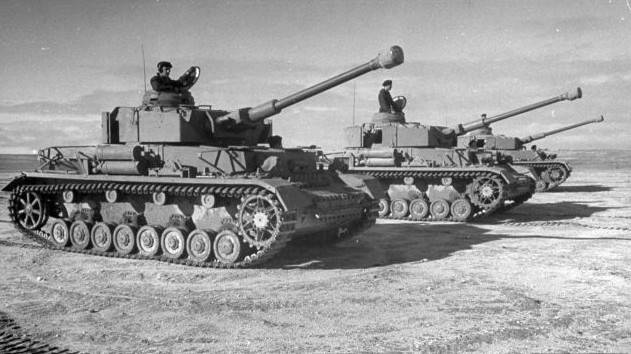
Spanish tanks Pz.Kpfw.IV Ausf. N
Tanks Pz.Kpfw.IV Ausf. N served in combat units until 1956. After which they were replaced by the American M24 Chaffee and M47 Patton, and the German tanks went into storage. Seventeen “fours” were sold to Syria in 1965. Another 3 tanks ended up in Spanish museums.
As part of military-technical cooperation with Germany, in 1944 Finland acquired 15 PzIV Ausf tanks. J, which performed well in difficult climatic conditions and when used in wooded areas.
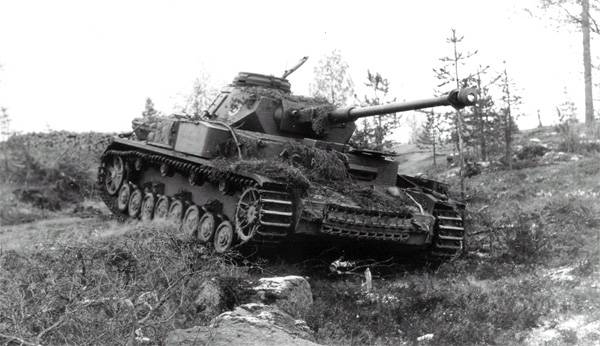
Although Finnish sources claim that not a single tank was irretrievably lost, in the post-war period no more than 10 “fours” remained in service, spare parts for which were dismantled from damaged vehicles. The final abandonment of the Pz.Kpfw.IV Ausf. J in Finland occurred in the mid-1960s.
There were a number of “fours” in the armed forces of Poland and Yugoslavia.
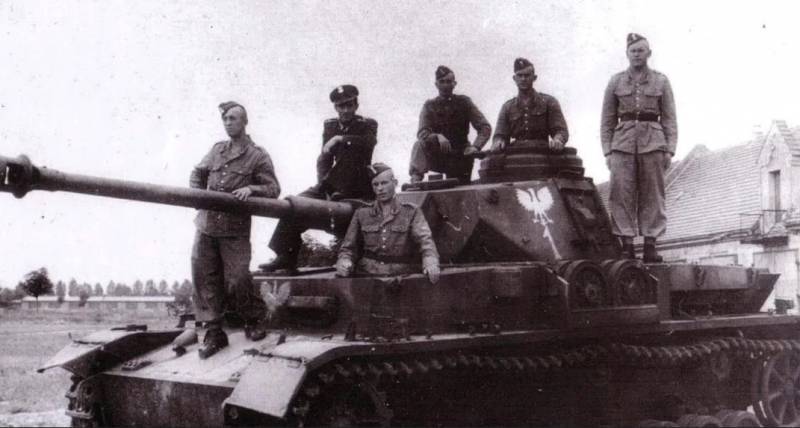
Polish Pz.Kpfw.IV, Poznan, 1946
Pz.Kpfw.IV tanks served in Poland until 1951, and in Yugoslavia until the end of the 1950s.
A significant number of “fours” and self-propelled guns based on them were in the Czechoslovak army in the first post-war years. The captured Pz.Kpfw.IV received the local designation T40/75. In total, about 50 “fours” of modifications J and N served in combat units.
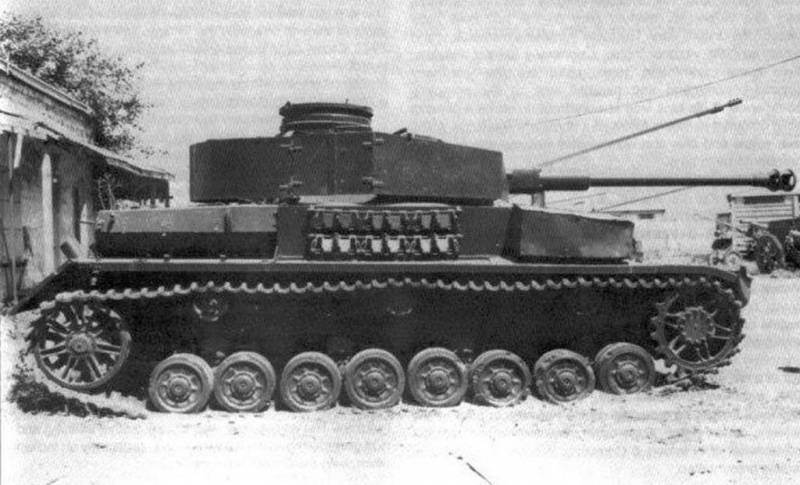
Czechoslovak tank T40 / 75
Operation of these machines continued until 1954. Approximately 30 more Pz.Kpfw.IV tanks located at storage bases were used as a source of spare parts.
Unlike the “fours,” Jagd.Pz.IV tank destroyers were used to a limited extent in the Czechoslovak army. Apparently, this was due to the fact that Czechoslovakia had StuG.III and Hetzer self-propelled guns in sufficient quantities.
After the liberation of France from the Nazis, several hundred German tanks and self-propelled guns suitable for further use remained on the territory of this country. Subsequently, some of these vehicles were adopted by French national armored units.
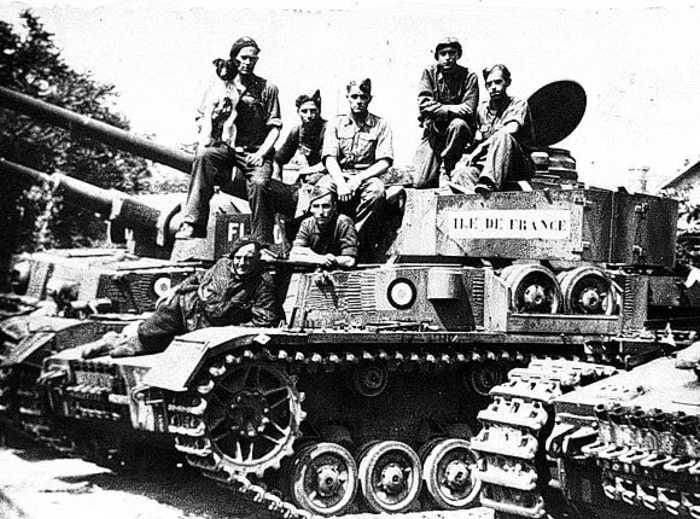
Tanks Pz.Kpfw.IV of the separate squadron "Benier"
French sources claim that in 1946, there were three dozen “fours” in the separate tank squadron “Beignets”. These were mainly tanks of the Pz.Kpfw.IV Ausf modification. H. Approximately the same number of medium tanks that were in storage served as donors for combat vehicles.
In the 1950-1960s, Syria became a major buyer of Pz.Kpfw.IV tanks. In the second half of the 1950s, contracts were signed with France and Czechoslovakia for the supply of approximately 80 tanks. The main reason for purchasing captured German tanks was their relatively low cost. Each “four” purchased in Czechoslovakia, excluding delivery, cost the Arabs 4500 pounds sterling. At current prices, this is approximately $120.
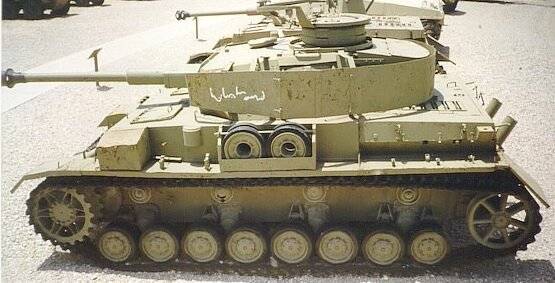
However, as we know, the miser pays twice. A significant part of the vehicles received were in poor technical condition, and the Syrian government had to additionally order spare parts and Maybach HL 120 TRM engines from Czechoslovakia.
The most valuable acquisition was the purchase of 17 Spanish Pz.Kpfw.IV Ausf. N, received in 1965. These machines were very well looked after in Spain, they had a large residual life and, with proper care, could serve for a long time.
More than half of the Syrian Pz.Kpfw.IVs lost the machine gun in the front plate - the ball mount was either empty or covered with an armor plate. At the same time, the position of gunner-radio operator was abolished, and instead of the German Fu 5 radio station, the commander was equipped with a modern analogue.
In parallel with the “fours,” a number of Jagd.Pz.IV tank destroyers with 75-mm guns with a barrel length of 48 calibers arrived from Czechoslovakia.
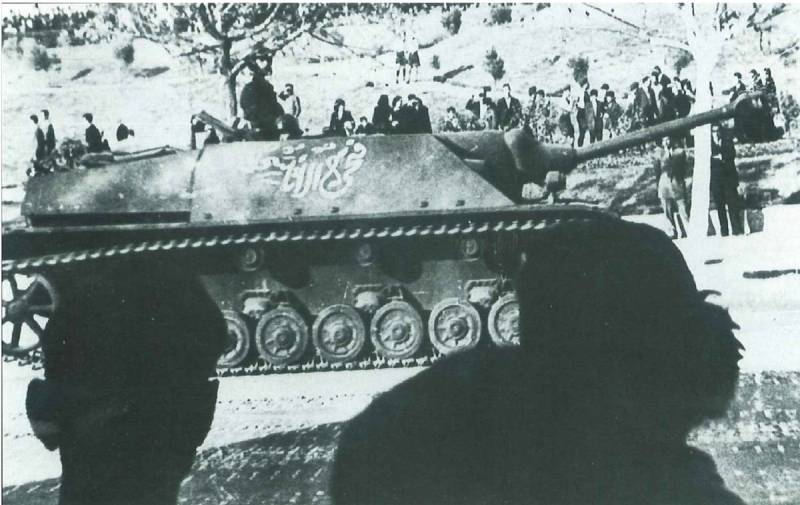
Tank destroyer Jagd.Pz.IV on parade in Damascus
Although in the mid-1960s the Pz.Kpfw.IV tanks and Jagd.Pz.IV self-propelled guns could no longer be considered modern, their 75-mm guns were powerful enough to fight the Shermans, of which the Israeli army had many.
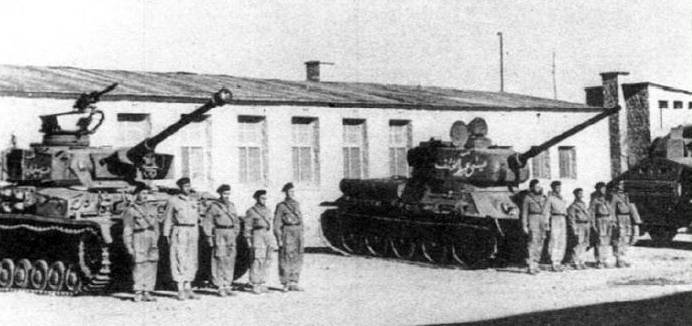
German-made tanks and self-propelled guns were distributed among three Syrian infantry brigades: the 8th, 11th and 19th. At the same time, the “fours” were operated in parallel with the Soviet T-34-85.
The Six-Day War was the last episode of the combat use of captured German tanks and self-propelled artillery units. Before the outbreak of hostilities, units equipped with German-made tanks were stationed on the Golan Heights and on the approaches to them.
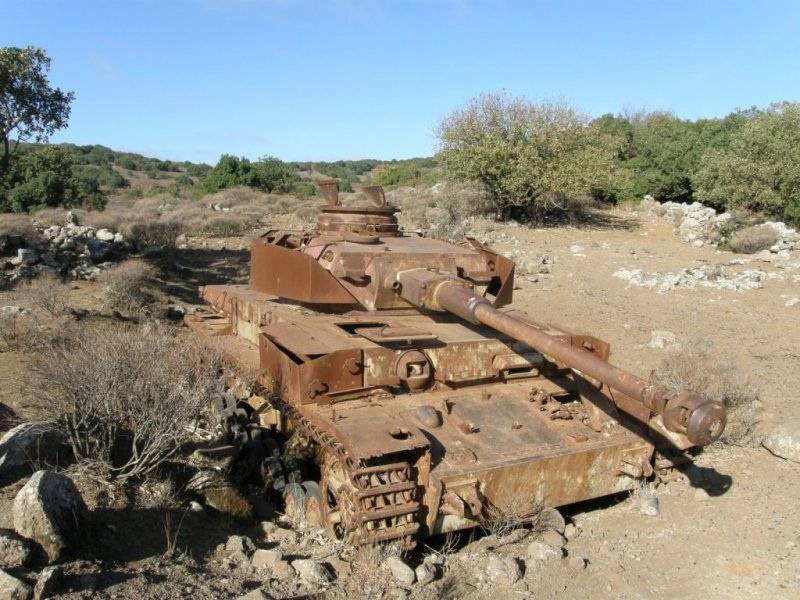
Tank Pz.Kpfw.IV, abandoned in the Golan Heights
In total, there were 201 units of Syrian armored vehicles in defense in this direction. Of these, about four dozen are German tanks and self-propelled guns. By that time, the Syrian armored forces were a conglomerate of Soviet and German-made tanks and self-propelled guns.
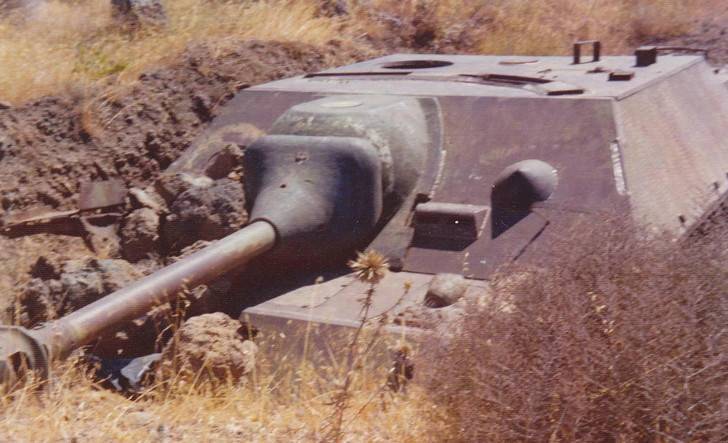
ACS Jagd.Pz.IV, abandoned in the Golan Heights
During the Six-Day War of 1967, most of the operational tanks and self-propelled guns made in the Third Reich were destroyed or captured by the Israeli army.
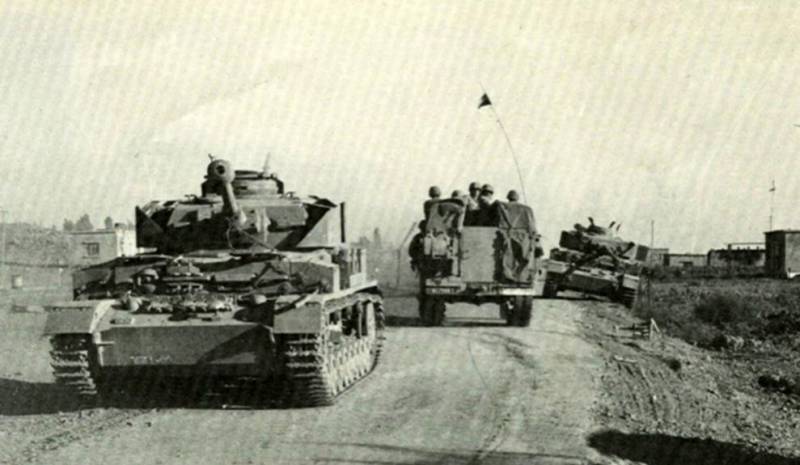
An Israeli patrol passes abandoned Syrian Pz.Kpfw.IV tanks
For a short period of time, the Israelis twice used captured tanks as long-term firing points.
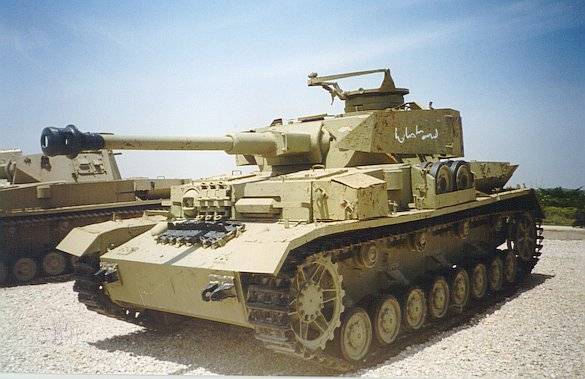
Syrian Pz.Kpfw.IV Ausf. J in the tank museum in Latrun
Four captured cars became monuments and exhibits in museums. Two more captured “fours” were used to evaluate the effectiveness of anti-tank ammunition at the training ground.
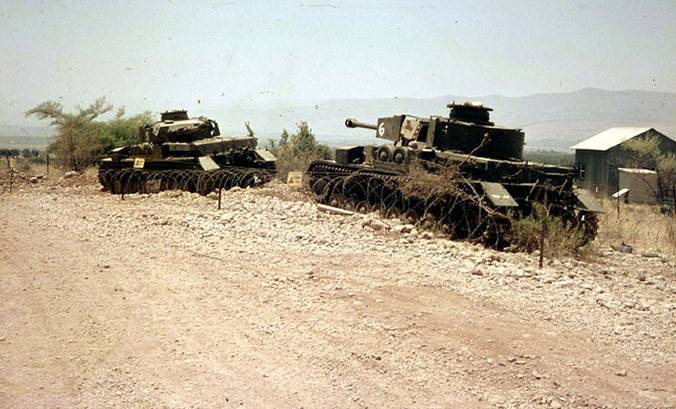
After the defeat, no more than two dozen Pz.Kpfw IVs remained in the Syrian army, and almost all of these tanks required repairs.
In the late 1960s, to restore the Arab armored forces, the Soviet Union began large-scale and mostly free deliveries of then modern tanks PT-76, T-55, T-62, IS-3M and self-propelled guns ASU-85 and SU-100. And by the beginning of the Yom Kippur War, which broke out on October 6, 1973, there were no longer German-made tanks and self-propelled guns in the Syrian army.
Tanks Pz.Kpfw.V Panther
After the end of hostilities, about two hundred serviceable or repairable Pz.Kpfw.V Panther tanks remained in the territories liberated from the Nazis.
The “Panther”, armed with a long-barreled cannon, with very good armor penetration and good armor protection in the frontal projection, was significantly superior to the “four” of all modifications in these indicators. But at the same time, in terms of maneuverability and operational reliability, the Pz.Kpfw.V was significantly inferior to the Pz.Kpfw IV tanks, as well as the StuG.III and Hetzer self-propelled guns, which became the reason for the short-term use of captured Panthers.
The first two Panthers were captured by the Poles during the Warsaw Uprising in August 1944. These vehicles were used in combat, but were damaged in fire duels with German anti-tank artillery, after which they were destroyed by Polish crews. Subsequently, despite the fact that the Polish Army had a lot of captured armored vehicles, there were no recorded instances of the use of Panthers.
In 1946, the Soviet Union transferred an unspecified number of Pz.Kpfw.IV and 13 Pz.Kpfw.V to Romania. The tanks entered service with the 1st Tank Brigade, which in 1947 was reorganized into the Tudor Vladimirescu Tank Division.
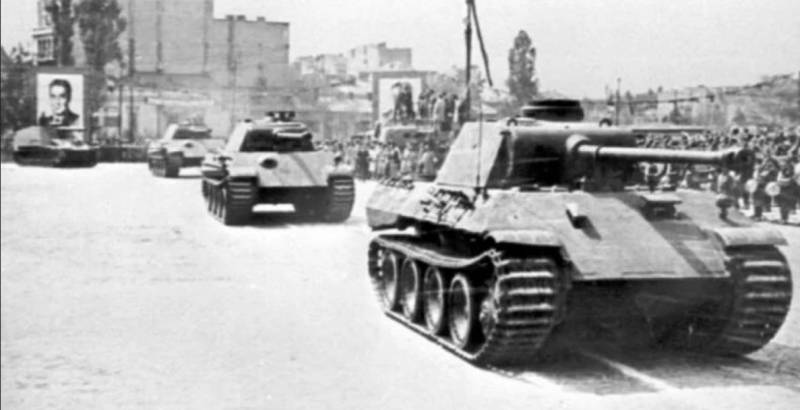
Pz.Kpfw.V tanks on parade in Bucharest, May 10, 1946
These vehicles were used in Romania until 1950, after which they were written off and scrapped for metal.
A noticeable number of Pz.Kpfw.V Panther tanks were available in Bulgaria. In the spring of 1945, a tank battalion was formed as part of the 1st Bulgarian Army, which, in addition to other armored vehicles, had 15 Panthers transferred by the Soviet side.
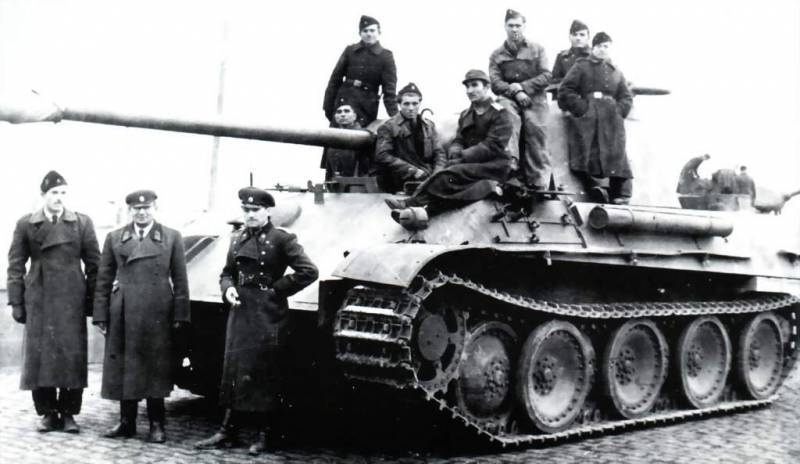
Bulgarian tank Pz.Kpfw.V
These tanks did not have the chance to take part in hostilities; the war ended before the crews completed their training.
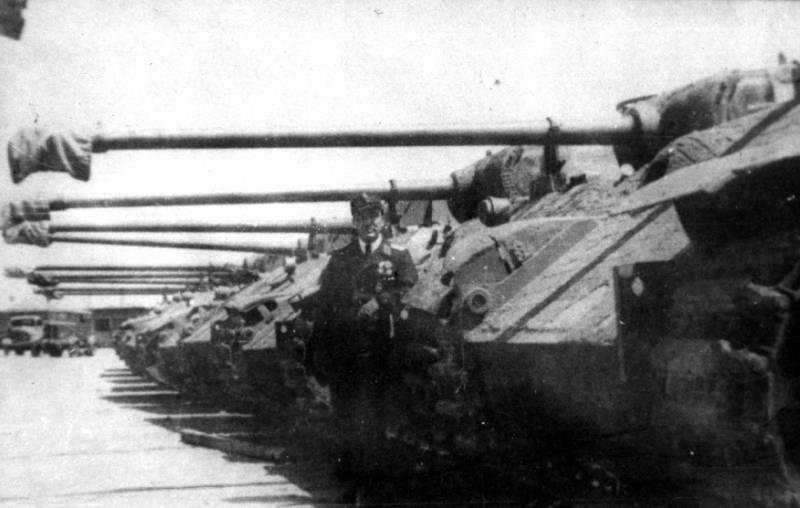
As of March 1, 1946, there were 14 combat-ready tanks in service, and one Panther was in need of repair.
From 1945 to 1948, the Soviet Union transferred 738 armored combat vehicles to Bulgaria: 398 T-34-85 and 340 SU-76M self-propelled guns. After which, further use of the Panthers, which were very problematic in operation, became pointless. Initially, it was planned to place the Pz.Kpfw.V tanks on the Bulgarian-Turkish border as bunkers, and install the dismantled Maybach engines on railway cars, but this was not implemented.
The first two Panthers were captured by the French resistance forces in the summer of 1944.
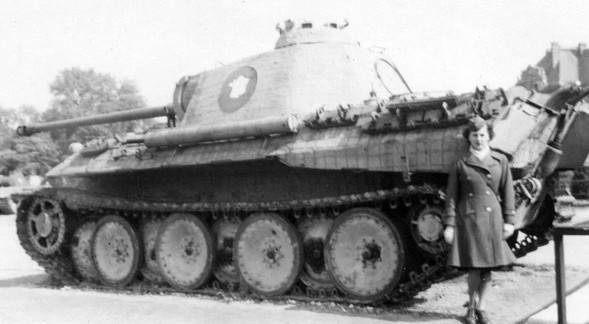
Pz.Kpfw.V tank captured by French resistance forces
At the end of the 1940s, the French army had a very varied tank fleet. American Shermans were used together with the German “fours” and self-propelled guns, and Pz.Kpfw.Vs served in the 501st and 503rd tank regiments, as well as in the 6th Cuirassier Regiment.
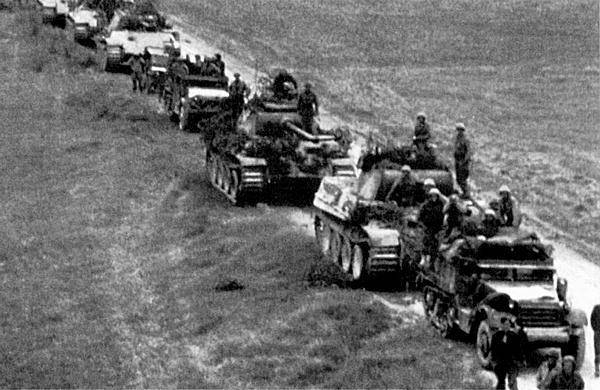
"Panthers" of the 503rd tank regiment in the same ranks with American-made armored personnel carriers, 1947
Although the Panther was a very complex and labor-intensive vehicle to repair and placed high demands on the qualifications of its driver mechanics, the French were greatly impressed by the security and firepower of this tank. As of 1949, the troops had about 70 Panthers.
Gun 7,5 cm KwK. 42 L/70, which was installed on the Pz.Kpfw.V Panther tank, had a significant influence on French tank armament.
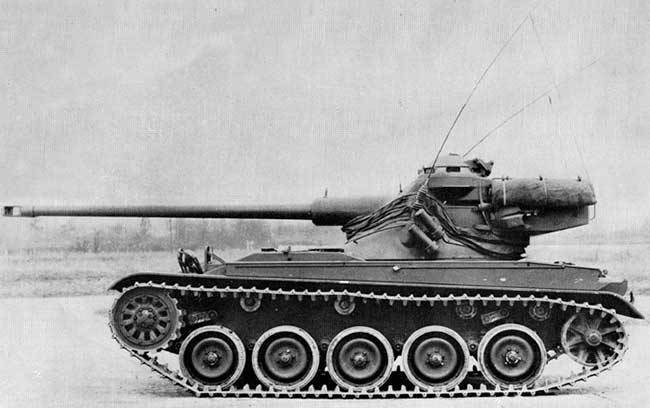
From 1952 to 1964, the AMX-13 tank was mass-produced, the early modifications of which used the 75 mm SA50 cannon, based on the German 7,5 cm KwK. 42 L/70.
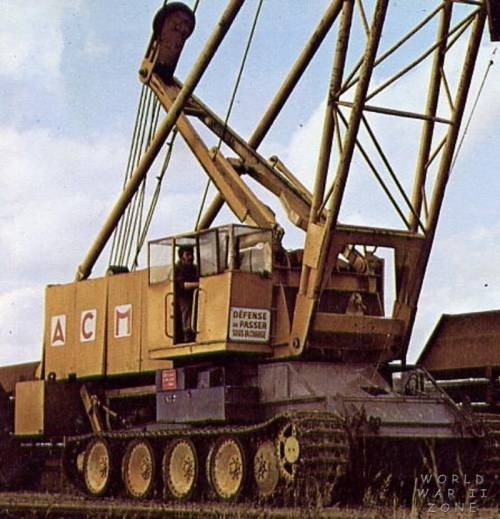
In the early 1950s in France, the chassis of decommissioned Panthers was used to produce self-propelled cranes.
Self-propelled artillery systems "Hetzer" and "Hummel"
As of May 9, 1945, Czech factories and tank repair shops had about 300 Hetzer self-propelled guns in varying degrees of readiness.
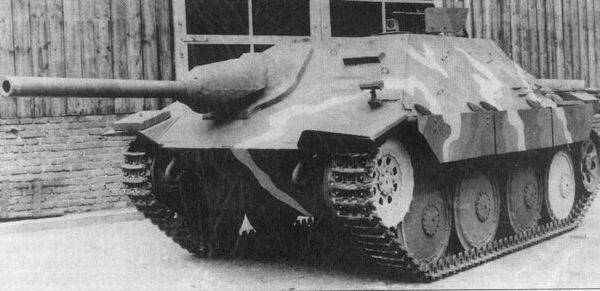
It was this self-propelled gun that became the most widespread in the armed forces of Czechoslovakia in the first post-war years. In November 1945, the Czechoslovak Tank Forces Headquarters issued an order to accept the Jagdpanzer 38(t) into service under the designation St-Vz.38. A total of 246 such vehicles were transferred to the Czechoslovak People's Army.
In the early 1950s, after licensed production of the Soviet T-34-85 and SU-100 was launched in Czechoslovakia, the process of decommissioning captured German tanks and self-propelled guns began.
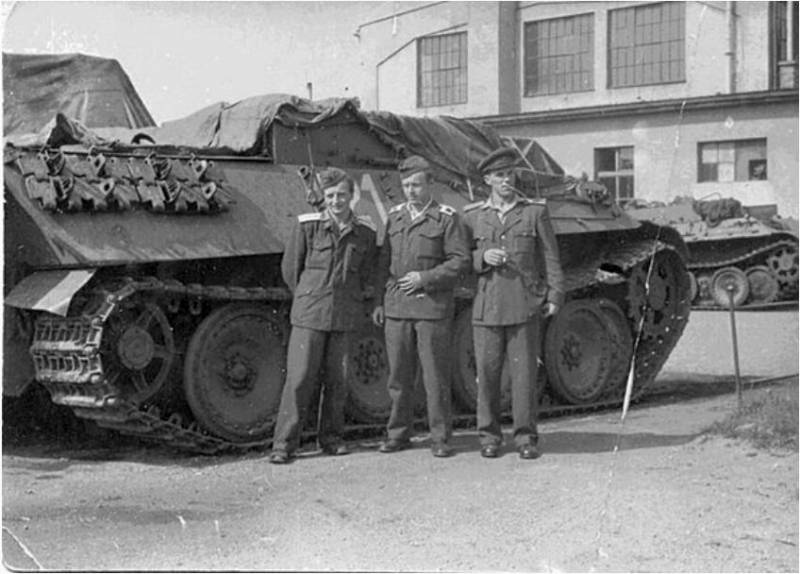
However, after the St-Vz.38 self-propelled guns were decommissioned, the operation of the Bergepanzer 1958(t) ARV and disarmed vehicles used for driver training continued until 38. At least one self-propelled gun was converted into a trencher.
In the post-war period, Switzerland became the buyer of the Hetzer, whose armored fleet consisted of 24 LTH light tanks - an export version of the LT vz.38, which served as the basis for the Hetzer self-propelled guns, and needed updating.
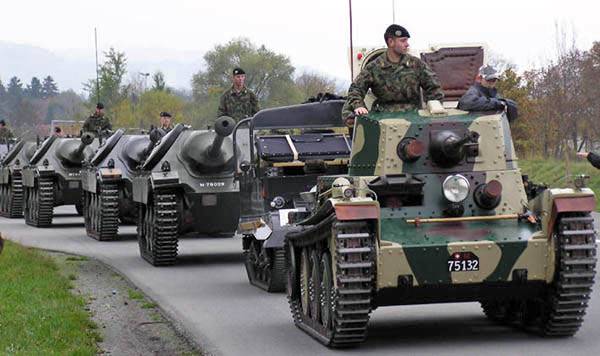
In August 1946, Skoda received a trial contract for eight self-propelled guns adapted to Swiss requirements. In Switzerland, this self-propelled gun received the designation Panzerjager G-13.
Externally, the Swiss tank destroyer can be easily distinguished from the Hetzer by its muzzle brake and optical instruments. Unlike the Jagdpanzer 38(t), which has bare sides of the wheelhouse, on the outer side of the armor of the Swiss tank destroyer there is a box with spare parts, tracks and a spare roller.
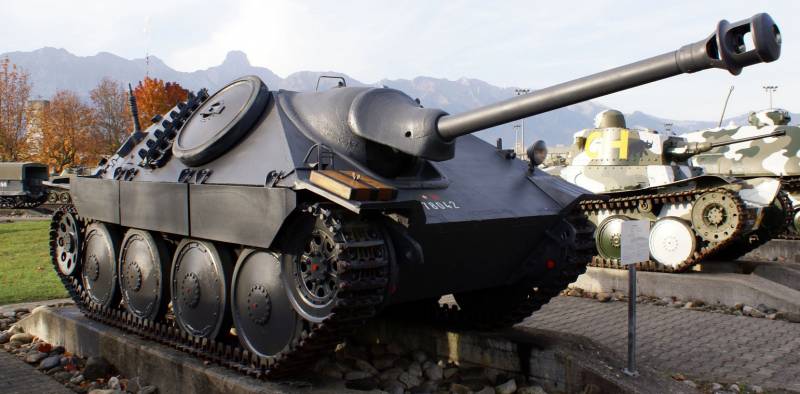
Using the reserves left over from the Germans, the first batch of self-propelled guns was quickly delivered to the customer. However, another order for 1946 self-propelled guns that followed in November 100 was on the verge of failure, since there were no Rak.39/2 guns available.
But a solution was found: Czech engineers quickly reworked the drawings, after which self-propelled guns began to be armed with 75-mm StuK.40 cannons, which were available in sufficient quantities in warehouses.
In addition, instead of a carburetor engine, starting from the 65th car, a Sauer-Arbon diesel engine with a power of 148 hp was installed. With. The fuel consumption of the diesel engine was more than half that of the gasoline engine. The efficiency of the new power plant made it possible to reduce the fuel tank from 250 to 115 liters, which made it possible to significantly increase the useful armored volume. The speed of the car on the country road remained at 25-30 km/h, and the range also remained almost unchanged.
The combat weight of the Panzerjager G-13 was a ton less than that of the German Jagdpanzer 38(t). A 2-chamber muzzle brake appeared on the gun of the Swiss tank destroyer; the commander and loader swapped places. A rotating observation device was installed on the roof, as well as a commander's viewing device in the armored turret.
In general, the “Swiss” version turned out to be more successful than the original modification. And in 1947, an order was placed for another 50 self-propelled guns. The last 20 vehicles were delivered to the customer on February 16, 1950. These tank destroyers were in service with the Swiss army until 1972.
A relatively little-known page is the post-war use of the 150 mm Hummel self-propelled gun (full name 15 cm Schwere Panzerhaubitze auf Geschützwagen III/IV (Sf) Hummel).
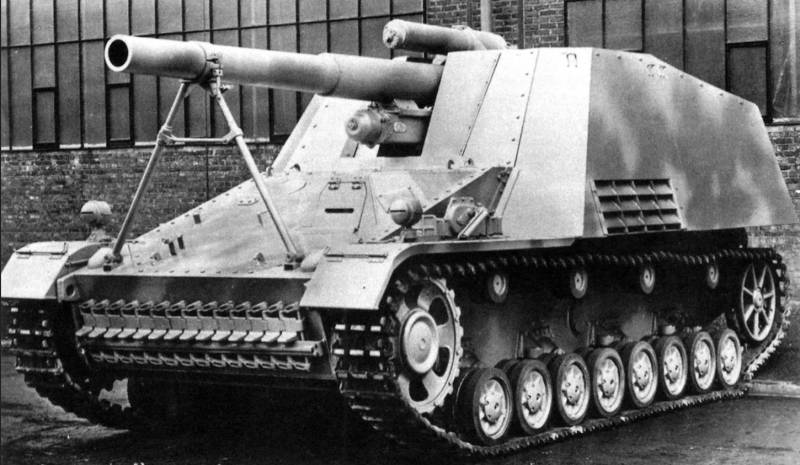
It is reliably known that these self-propelled howitzers, quite good by the standards of World War II, were available in the armed forces of Romania and France in the late 1940s.
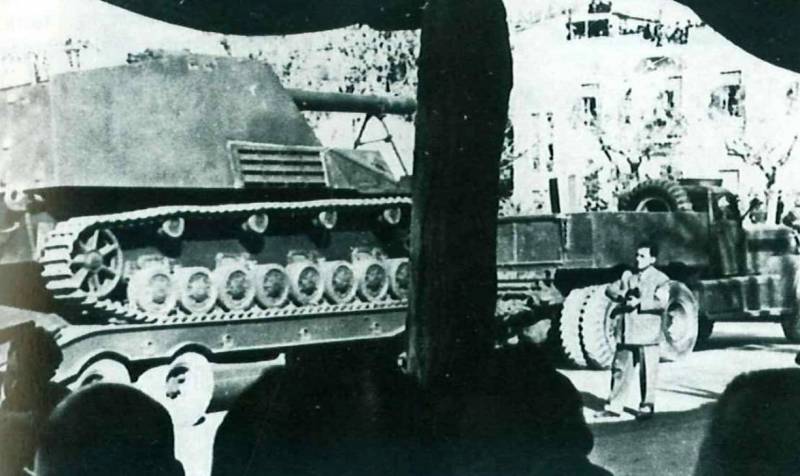
In the second half of the 1950s, France sold five Hummel self-propelled guns to Syria. Unfortunately, there is no information about their fate. Apparently, all German-made 150mm self-propelled guns were destroyed during the 1967 war.
Продолжение следует ...
Information